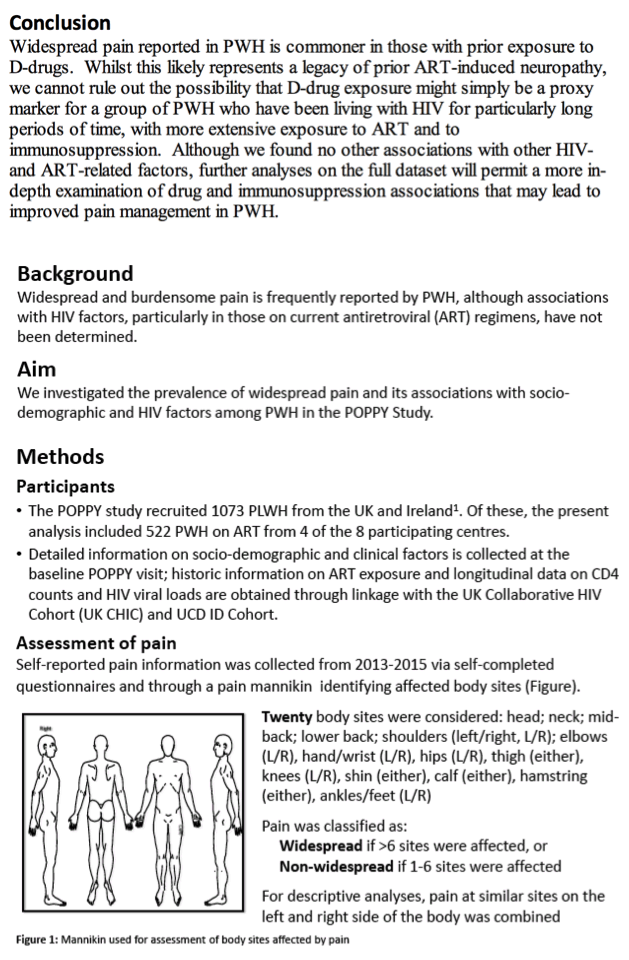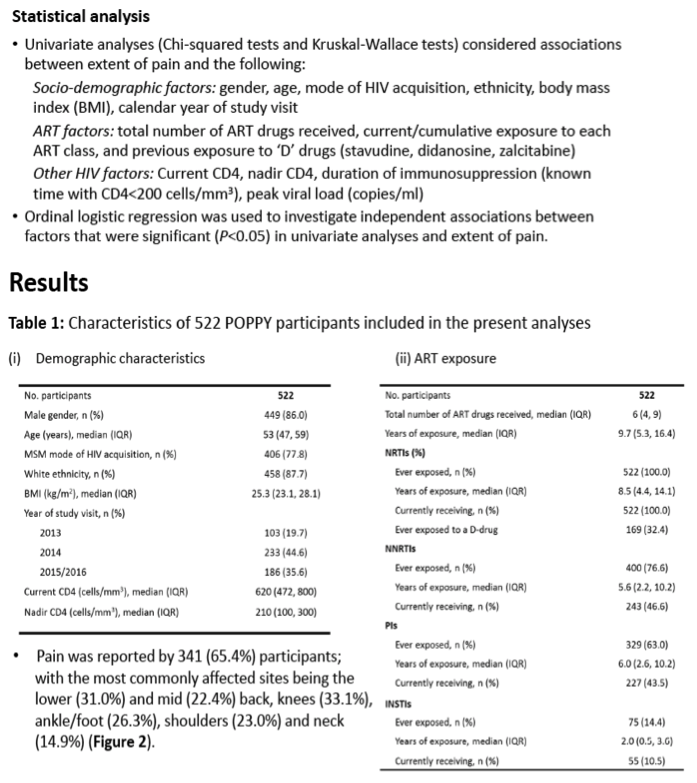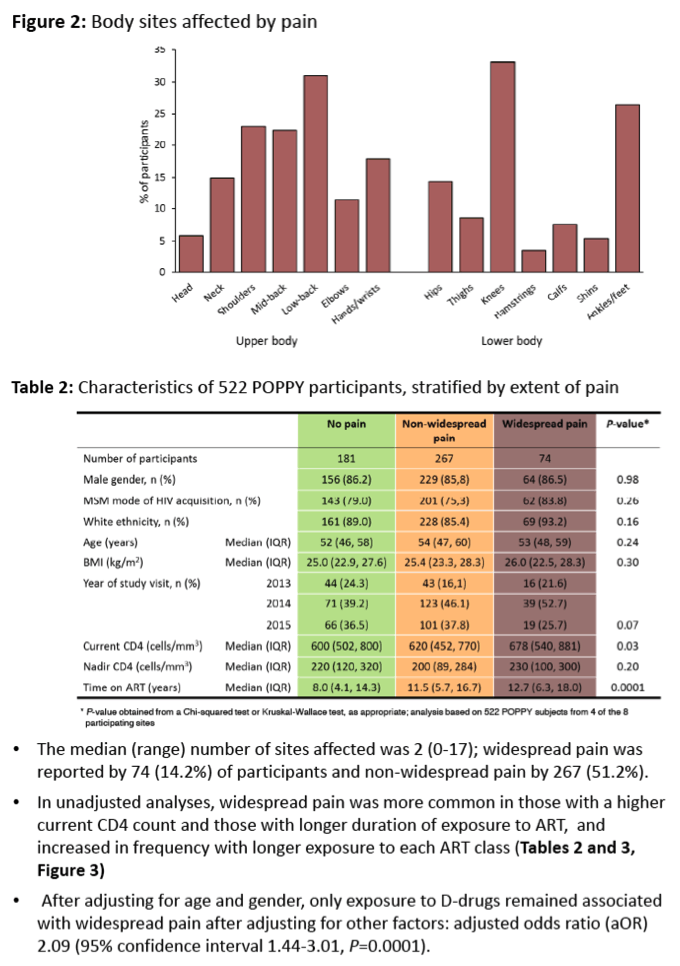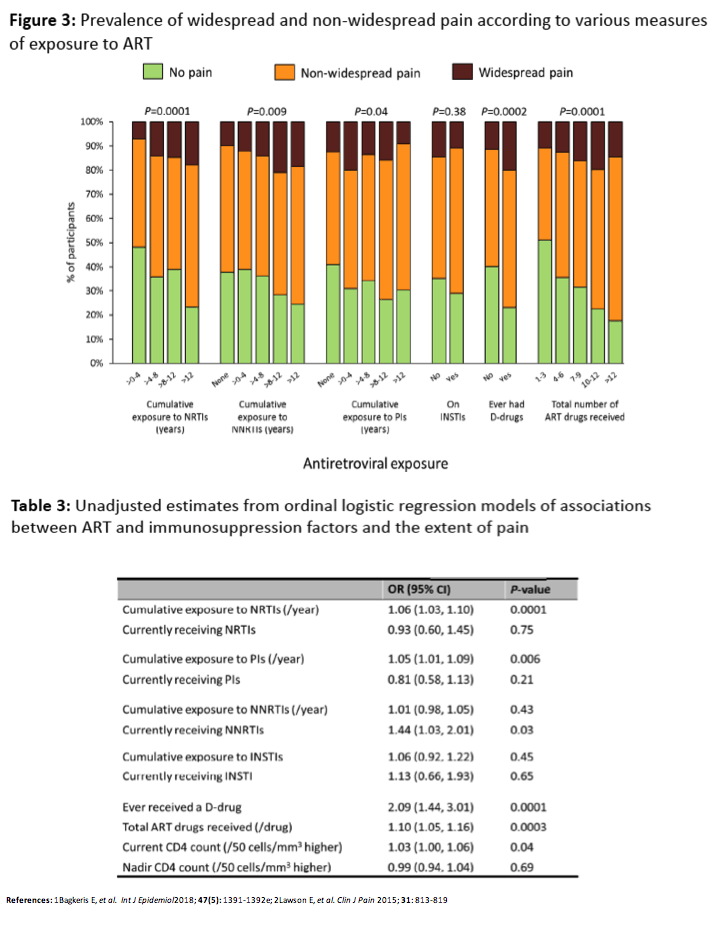 |
 |
 |
| |
Two thirds of HIV group report pain and 14% endure "widespread" pain
[50% to 80% report pain, average age only 53]
|
| |
| |
Conference on Retroviruses and Opportunistic Infections (CROI), March 4-7, 2019, Seattle
Mark Mascolini
Two thirds of a 522-person HIV group reported some pain, and 14% reported widespread pain affecting more than 6 sites [1]. A history of taking d-drug nucleosides (didanosine, stavudine, zalcitabine) doubled chances of widespread pain, but the precise reason for this association remains open to speculation.
Researchers working with the UK/Ireland POPPY cohort noted that people in the current antiretroviral era still report pain, often widespread pain. Because HIV factors related to pain remain largely unexplored, the POPPY team conducted this cross-sectional study.
POPPY has recruited more than 1000 UK/Ireland residents with HIV. This analysis focused on 522 people currently taking antiretroviral therapy (ART). In 2013-2015 participants self-reported pain with a questionnaire and a "pain manikin" with 20 distinct body sites. Researchers defined pain as widespread if it affects more than 6 sites. They used ordinal logistic regression analysis to identify independent pain predictors after adjustment for other variables.
Most study participants (86%) were men, 88% were white, median age stood at 53 (interquartile range [IQR] 47 to 59), and median current CD4 count measured 620 (IQR 472 to 800). These people had taken a median of 6 antiretrovirals (IQR 4 to 9) and had a median 9.7 years of ART exposure (IQR 5.3 to 16.4).
The researchers counted 341 people (65%) who reported any pain, usually involving the knees (33%), lower back (31%), ankle or foot (26%), shoulders (23%), midback (22%), or neck (15%). Seventy-four of these 341 people (14% of 522) reported widespread pain. Comparing the groups with no pain, nonwidespread pain, and widespread pain, the researchers found no significant difference by gender, white ethnicity, age, body mass index, or nadir CD4 count. Current CD4 count was significantly higher in the widespread group (median 678 versus 620 nonwidespread and 600 no pain, P = 0.03), and time on ART was significantly longer in the widespread group (median 12.7 versus 11.5 versus 8.0 years, P = 0.0001).
An unadjusted analysis determined that widespread pain was more frequent in people with a higher current CD4 count, more total antiretroviral drugs taken, longer exposure to nucleosides or protease inhibitors (PIs), or ever taking a d-drug, at the following odds ratios (OR):
-- Higher current CD4 count: OR 1.03 per 50 cells higher, P = 0.04
-- More total antiretroviral drugs: OR 1.10 per each additional drug, P = 0.0003
-- Longer exposure to nucleosides: OR 1.06 per year, P = 0.0001
-- Longer exposure to PIs: OR 1.05 per year, P = 0.006
-- Ever taking a d-drug: OR 2.09, P = 0.0001
After adjustment for age and gender, only ever taking a d-drug remained an independent predictor of widespread pain, more than doubling the odds (adjusted OR 2.09, 95% confidence interval 1.44 to 3.01, P = 0.0001).
POPPY investigators speculated that the link between ever taking a d-drug and widespread pain could reflect the long-term impact of d-drug-induced neuropathy. But they could not rule out the possibility that d-drug exposure merely flags those participants who have lived longer with HIV and thus took antiretrovirals longer and spent a longer time with a low CD4 count. They plan further analyses of the full dataset to explore the impact of drug- and CD4-related factors with an eye toward improving pain management in people with HIV.
Reference
1. Sabin C, Nahomi K, Harding R, et al. Widespread pain and associations with HIV-related factors in people with HIV. Conference on Retroviruses and Opportunistic Infections (CROI). March 4-7, 2019. Seattle. Abstract 698.
--------------------------
WIDESPREAD PAIN AND ASSOCIATIONS WITH HIV-RELATED FACTORS IN PEOPLE WITH HIV (PWH)
C.A. Sabin1, K. Nkhoma2 , R. Harding2, A. Geressu1, E. Bagkeris1, P.W.G.Mallon3,
F.A.Post4, M. Sachikonye5, A. Milinkovic6, J. Anderson7, J. Vera8, M. Johnson9, I. Williams1, and A. Winston10for the POPPY study group





|
| |
|
 |
 |
|
|